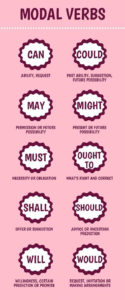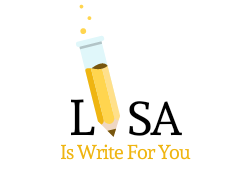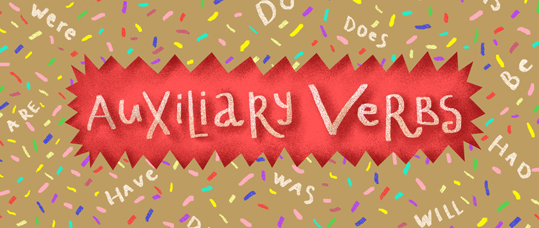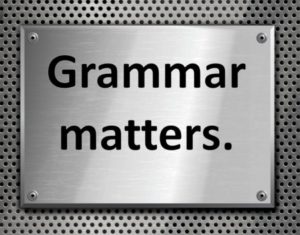The English language is like a machine and like a machine, the English language consists of many parts. Auxiliary verbs in the English language is like brakes to a car, you need them to get from point A to point B. These verbs serve many purposes and are necessary as you will see. You need them to make most sentence structures work in our everyday machine called English.
Auxiliary Verbs
Auxiliary verbs or, helping verbs in which they are commonly called, are verbs that are used in conjunction with the main verb in order to decipher the tense of the verb, tense meaning past, present, or future. Auxiliary verbs also contribute grammatical and functional meaning structurally to the clauses or sentences in which they are used and will usually appear with the main verb. Also, there can be more than one of these verbs in a sentence but should not be more than three. Helping verbs are used in several ways, let’s take a look:
- Convey tense: (Gives a record in time in which something happened) Example: “Lee is eating the grapefruit.” Or, “Jim has gone to the game alone.” The examples show the auxiliary verb is in the first sentence and main verb eating, representing something that is happening in real-time. The second example shows the helping verb has and the main verb gone, representing something that has already happened.
- Aspect in the grammatical sense: (Shows correlation between the verb and the flow of time)
- Modality: (Helps define or give expression or mood to the verb)
- Gives a voice: (Helps specify whether the subject is the one performing the action, also known as the active voice which tells what a person or thing does. An example of this is, “Sue ate two hamburgers at lunch.” Here you see the subject Sue performed the act of eating two hamburgers, ate being the verb. Auxiliary verbs can also specify whether the subject is acted upon instead by the verb, also known as the passive voice which tells what is done to something or someone. Let’s take the same example and switch it to passive voice. “At lunch, two hamburgers were eaten by Sue.” As you can see, the subject Sue in this sentence was essentially acted upon by the verb were eaten.
- Emphasizes sentence: (Gives clarity, stresses a point and also helps to make an idea stronger.)
23 Auxiliary Verbs
Now that we know the functions of these very important verbs, let’s now talk about what these verbs exactly are. There are a total of 23 helping verbs in the English language, and as stated above, each serves its own purpose in a sentence. These verbs help to express the mood of the writer, and the time period in which the event is happening in the sentence. They also give a voice, which in turn gives clarity, and they also make the sentence much stronger. So what exactly are these important verbs? Let’s take a look:
am, is, are, was, were, being, been, be, had, do, have, has, does, did, will, would, should, shall, may, might, must, can, could
Out of the 23 helping verbs, the three most common of them can either stand-alone be used as an auxiliary verb. They also break down into several forms, let’s take a look:
- To be: am, is, are, was, were, wasn’t (was not), aren’t ( are not), be, being, been, to be, weren’t ( were not)
- To have: has, have, having, had, hadn’t ( had not)
- To do: to do, do, does, done, did, didn’t, doesn’t (does not)
Now that we know the 23 Auxiliary verbs and the different forms, let’s look at some examples and verb phrases:
- “Tom is taking Betty to the car rental agency.”
- “Unfortunately, the order has been canceled by the vendor.”
- “The breakfast was finished before I woke up.”
- “Did the dog eat the cake?”
- “I must call the doctor today to make my appointment.”
- “That doesn’t make sense let me take a look.”
Out of the 23 verbs, the most common ones are: have, be, and do; commonly called primary verbs but are not always helping verbs. For example, Sarah doesn’t eat chocolate cake. In this example, doesn’t is a helping verb but in this sentence: Sarah does long hikes on the weekend. Does is just an ordinary verb. The most common of all is the verb to be.
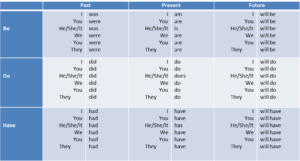
The Most Common Verb: To Be
In the English language, one of the most common verbs is the verb to be. When speaking in the present tense, this popular verb is usually used to describe something or someone. More specifically, the verb to be is commonly used to describe or talk about nationalities, names, ages, professions, and even feelings.
What really makes this verb so special? Out of all the verbs in the English language, the verb to be has the title of being one of the most irregular verbs, meaning, this verb changes entirely in mostly all of its forms. Whereas regular verbs rarely change in their different tenses. Because of this, depending on the tense, (past, present, future) this special verb is written differently to make it’s meaning clear. This verb also changes depending on the subject as well. Let’s dig deeper into the different forms of this sneaky verb.
Be: Base Form
Be, the base form and the most basic form of the verb to be is what will appear in the dictionary. This form is mostly used in the imperative mood which describes something crucial or of vital importance. This form also reflects a request or a command for example, “Be nice!” This form is also used in the infinitive form, or, the base form. For example, “She likes to be on time every day.”
Present Tense: 3 Forms
The verb to be has three present tense forms, am, is, and are. It can also change its meaning depending on the context in which it is used. What also makes this verb unique is that the present form of the verb can be shortened when written. To make this more clear, first let’s take a look at at all the subject pronouns for the verb to be:
- I
- You
- He
- She
- It
- We
- They
Next, let’s take a look at the short and long forms for affirmative sentences, simply put, sentences that states something to be true or valid from the above subjects for the verb to be:
- I – I am (Long) – I’m (Short)
- You – You are (Long) – You’re (Short)
- He – He is (Long) – He’s (Short)
- She – She is (Long) – She’s (Short)
- It – It is (Long) – It’s (Short)
- We – We are (Long) – We’re (Short)
- They – They are (Long) – They’re (Short).
As you can see, each verb phrase example is in its present tense form and states something to be true and or valid. Now, let’s look at some clauses with the verb to be in negative form in both its long and short version:
- I – I am not (Long) – I’m not (Short)
- You – You are not (Long) – You aren’t (Short)
- He – He is not (Long) – He isn’t (Short)
- She – She is not (Long) – She isn’t (Short)
- It – It is not (Long) – It isn’t (Short)
- We – We are not (Long) – We aren’t (Short)
- They – They are not (Long) – They aren’t (Short).
As I stated earlier, the verb to be is commonly used to describe or talk about nationalities, names, ages, professions, and feelings. Let’s take a look at some of these sentences:
- Nationalities: “They are from Sweden.”
- Names: “He is Tom.”
- Age: “She is 24 years old.”
- Profession: “You aren’t a chef, you are a receptionist.”
- Feelings: “Alex and Tammy are excited.”
Past Tense: Was/Were
Once again, the very unique verb to be change forms to was and were when in past tense form, let’s take a look at the different versions with the different subject pronouns:
- I – I was (Affirmative) – I was not (Negative/Long) – I wasn’t (Negative/Short)
- You – You were (Affirmative) – You were not (Negative/Long) – You weren’t (Negative/Short)
- He – He was (Affirmative) – He was not (Negative/Long) – He wasn’t (Negative/Short)
- She – She was (Affirmative) – She was not (Negative/Long) – She wasn’t (Negative/Short)
- It – It was (Affirmative) – It was not (Negative/Long) – It wasn’t (Negative/Short)
- We – We were (Affirmative) – We were not (Negative/Long) – We weren’t (Negative/Short)
- They – They were (Affirmative) – They were not (Negative/Long) – They weren’t (Negative/Short).
Past Participle: Been
This form of the verb to be is the same with all subjects and is used in conjunction with past participle with present perfect (e.g., “She has been a perfect employee for months.”) and past participle with past perfect (e.g., “She had been working two jobs before she received a raise on her main job.”)
This verb form, in both participle forms can also sometimes be used as an adjective when describing an event that began in the past and is currently still happening, for example, “The movie ratings have been pretty good.” As you can see, the movie ratings are something that started in the past but is still continuing.
Present Participle: Being
By adding –ing to the base verb be, we now form the present participle with continuous tenses of the verb to be… to indicate that an event is happening now, frequently happens, or may happen. Just like the past participle, this form is the same with all subjects. Let’s take a look at a few examples:
- Tim is being serious for the first time ever.
- They had been being cooperative for a long time.
- He has been being curious until he learned the truth.
- She is being strict with the children.
As you can see in the above examples, all of the sentences show events that are happening currently or frequently. In the second past perfect example and the third, present perfect examples, the sentences appear to not be grammatically correct yet they are.

Modal Auxiliary Verbs
Auxiliary verbs also consist of modal verbs (can/could, will/would, may/might, etc.) Other than the three most common auxiliary verbs have, do, and be, there are additional helping or auxiliary verbs that are called modal auxiliary verbs (can, could, may, might, must, ought to, should, shall, will, would).
Think of modal auxiliary verbs as information verbs. These verbs communicate to the receiver the function of the main verb that it oversees and also express the modality in a clause or in simple terms, the ability, likelihood, permission or obligation of an act.
However, these verbs are without some forms. Meaning, they do not have a third or singular present tense forms. To make it easier to understand, sentences such as he mays, they cans, and it woulds does not make sense grammatically, nor do they have an infinitive form or commonly known as a form in its base form which is the form that appears in a dictionary. There are three types of modal auxiliary verbs, and depending on the function, which can range on a scale from “may”, meaning possibility and “must”, meaning necessity will determine which type they lie.
- Epistemic Modality: Verb that expresses the likelihood, certainty, or possibility of being true or untrue.
- Deontic Modality: Verb to give permission, or express the need to perform a duty.
- Dynamic Modality: Will be by “can” or “will”. This verb type expresses the requirement for the subject to do something.
Let’s take a look at an example of each:
- Epistemic- You may be on the right track.
- Deontic- He can stand there as long as he wants.
- Dynamic Modality- You will eat all of the vegetables.
In example one, with the epistemic verb type, it shows that the auxiliary verb may, shows the possibility of being on the right track. In example two, the auxiliary verb can show the need to perform an action or duty, and in example three, the auxiliary verb will express a requirement.
Past Or Not The Past?
Modal auxiliary verbs also differ in another way from lexical verbs which are all the verbs with the exception of auxiliary verbs. These verbs in their base form of the past tense form normally do not reflect the past. Shall, will, can, and may are the present tense of should, would, could, and might, which are the past tense forms.
Could is the only modal past tense form that normally is used to reference past time, for example, I could dunk the basketball when I was in high school. Yet, take for example the sentence, She would come to the reunion if she had time off from work.
Although would is the past tense form, it does not reflect the past. It seems as if the reunion is a current event, but if we changed its base form to would’ve, then it makes it clear that the reunion was a past event that she would have come to if she had time off from work.
With all this said, it is important to note that all auxiliary verbs are not modal verbs, yet all modal verbs are auxiliary verbs.
